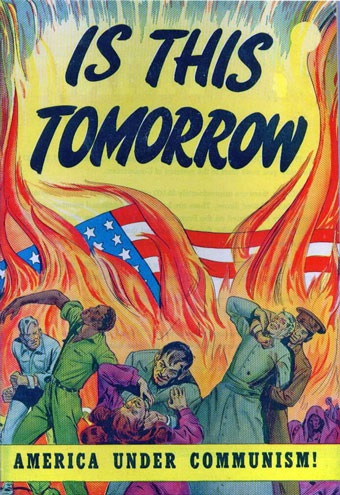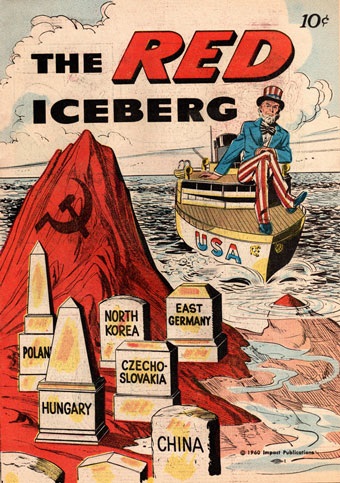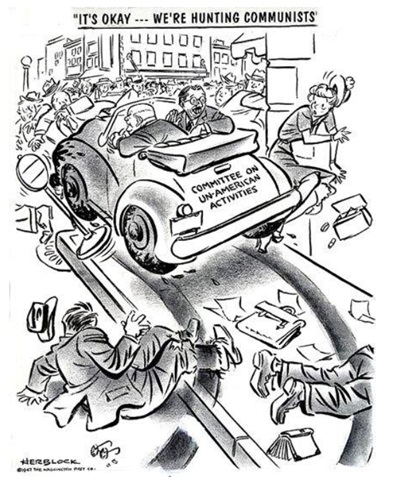|
       
McCarthyism, 1950-54
|
|
|
On 9 February 1950, recently-elected Senator Joseph R McCarthy
gave a talk to the Women's Republican Club of Wheeling, West Virginia. What he had to say shocked the nation:
Source A
Today we are engaged in a final, all-out battle between communistic atheism, and Christianity. The modern champions of communism have selected this as the time. And, ladies and gentlemen, the chips are down – they are truly down.
While I cannot take the time to name all the men in the State Department who have been named as members of the Communist Party and members of a spy ring, I have here in my hand a list of 205.
Josepth R McCarthy, speaking at Wheeling, West Virginia, 9
Febuary 1950.
The four years that followed are known as the 'McCarthy Witch-hunt':
|
Going Deeper
The following links will help you widen your knowledge:
Basic accounts from
BBC
Bitesize

The film
Good Night and Good Luck (2005) tells the story of how TV presented
Ed Morrow dared to take on McCarthy. If you can, watch the whole film.
 Essay:
Why was there such a fear of communism in early 1950s America? Essay:
Why was there such a fear of communism in early 1950s America?
 Essay: How did McCarthyism affect American society? Essay: How did McCarthyism affect American society?
|
Causes of the Witch-hunt
[FASCISM]
-
Fear of Communism
The long-standing embedded belief, going back to the
‘Red Scare’ of the 1920s, that
Communism was about to destroy American democracy, freedom and way of life,
and the government had been taking action against Communism before McCarthy.
HUAC: The House Un-American Activities
Committee (HUAC) had been created by Congress in 1938 to investigate private
citizens, public employees and organizations suspected of disloyalty.
Before the war it also investigated Nazis and Japanese Americans, but its focus
was always on Communists.
The Smith Act of 1940 made it a criminal offence to "advocate, abet, advise or teach [the] desirability or propriety of overthrowing the Government of the United States".
In 1942, the Department of Justice started keeping a list of (154) organizations it deemed subversive.
-
Anti-Union sentiment
The Unions were seen as by many, especially
Republicans, as damaging to the US economy & capitalism, and hotbeds of
sedition.
-
In 1947 the Taft-Hartley Act
imposed restrictions on Unions, prohibiting
secondary picketing,
closed shops, allowing states to pass ‘right-to-work’ laws, and requiring all
union officials to sign an affidavit that they were not Communists.
-
The strikes of 1949: In fact, Union activity was much reduced in the years after 1946, but a small economic downturn in 1949 caused some prominent strikes, including a 3-week strike by 60,000 Ford workers, and strikes by 1 million miners and 500,000 steelworkers, both demanding pensions & insurance as well as significant wage increases.
This created a sense of alarm.
-
Spy cases
-
Elizabeth Bentley and Whittaker Chambers:
were two Soviet spies who in return for immunity accused a number of
government officials of being spies (including Alger Hiss).
-
Alger Hiss: In 1948 Alger Hiss, a US government official who had helped set up the United Nations, was accused of spying for the USSR in the 1930s. Hiss was eventually sentenced to 5 years imprisonment for perjury.
This was the case that prompted McCarthy to make his speech at Wheeling.
Ethel and Julius Rosenberg : in 1953
man-and-wife team Ethel and Julius Rosenberg were executed, and a number of
co-conspirators imprisoned, for leaking information to the USSR about
American radar, jet technology, and nuclear weapons.
-
Cold War
After WWII, the USA and the USSR had entered into a period of enmity-without-fighting called the ‘Cold War’ – in 1947 President Truman had declared the
Truman Doctrine
that it was America’s duty to intervene in foreign affairs to ‘contain’
communism and protect democracy.
In the late 1940s a number of events led to a
significant fear of a nuclear war with the USSR and a Communist invasion:
- Click on the
u orange arrow
to reveal more information.
- • In 1948 Communists took over the government of Czechoslovakia, the last free democratic country in eastern Europe – an event which prompted Congress to agree the Marshall Plan, pumping $_millions in the economies of western Europe.
- • In June 1949, Stalin closed all land access to West Berlin – the ‘Berlin Blockade’.
- • In August 1949 the USSR successfully tested an atomic bomb, leading to an arms race. In US schools, children were taught
to ‘Duck and Cover’ in case
of a nuclear missile attack.
- • In October 1949, Communists took over the government of
China.
- • In June 1950, Communist North Korea invaded and almost conquered democratic South Korea – leading America into the three-year
Korean War.
-
Intelligence
In 1943, the National Security Agency started the Venona
Project to monitor Soviet spying; when some Venona materials were
declassified in 1995 it became clear that a level of espionage was indeed
taking place.
-
Swing to the Republican
Party
President Truman was a Democrat. However, during his
Presidency support for the more right-wing Republican Party began to grow;
Republicans generally supported McCarthyism, using it as a central theme
which helped them gain political power in the Congressional and Presidential
elections of 1952.
-
Media sensationalism
All these factors created a sense of
panic in the public mind, to which the media played:
As you saw in your study of Popular Culture, many of
the films of the 1950s were about invasions of alien creatures and
Communists taking over America.
Newspapers, magazines and cinema newsreels
sensationalised stories about alleged communist infiltration, often without
evidence.
|
Did You Know
In 1938 one of the HUAC members suggested that the English Elizabethan playwright Christopher Marlowe
(1654-93) was a Communist.
Source B

This 1947 comic book, published by the Catholic Guild Educational Society in 1947 – a story of how Communism
took over the USA – claimed there were 85,000 Communists in the USA, working "day and niight to overthrow YOUR GOVERNMENT!"
Source C

This 1960
comic book, also by the Catholic Guild and distributed to thousands of
Catholic school children, warns of Communist successes in the Cold War.
|
McCarthyism [HELPER]
-
Hollywood Ten
In 1947 HUAC investigated the ‘Hollywood Ten’ – ten
Hollywood filmmakers. They were fired, fined, imprisoned and blacklisted. Some had to move to Europe; others were unable to find work ever agin. Some 300 other actors, screenwriters, artists,
civil rights activists scientists and celebrities were accused and
blacklisted, including
Charlie Chaplin, comedienne
Lucille Ball, NAACP
founder
WEB Du Bois,
Robert Oppenheimer (of atomic bomb fame), playwright
Arthur Miller, and protest singer
Pete Seeger.
-
Exposing suspects
The FBI, led by J Edgar Hoover, sought out Communists by illegal means, including burglaries, opening mail, wiretaps, undercover operations and planting forged documents.
From 1951-55 the FBI leaked FBI files to the employers of suspected teachers,
lawyers etc.
Government departments regularly carried out
loyalty reviews – it has been suggested that one in five government
employees were investigated.
-
Groups such as the
American Legion and the
Minute Women of the USA organised tens of thousands of people into study groups,
letter-writing networks and patriotic clubs dedicated to rooting out
communism.
Private investigative firms, such as AWARE, were set
up which accused people of being Communists, causing them to be fired just
because accused. Journals such as Counterattack published
lists of accused organisations and individuals.
-
Homosexuality was against the law, and homosexuals were
put under surveillance because they were deemed susceptible to blackmail by
Soviet agents. As a result Truman sacked 425 government employees accused
of homosexuality, and Eisenhower signed Executive Order 10450, barring
homosexuals from working in the federal government, as a result of which some
5,000 gay people lost their jobs … and were outed to friends and family.
-
Permanent Subcommittee
on Investigations
From 1953, the PSI was chaired by McCarthy. It
held 169 hearings 1953-54, calling 653 people.
McCarthy’s methods were immoral and undemocratic.
He publicly accused people with little or no evidence, and intimidated the
accused by attacking their personal character and questioning their loyalty
to America.
-
End of the Scare
The McCarthy witch-hunt alarmed many people, some of whom dared to speak out:
In 1953, Truman called it “the corruption of truth, the abandonment of the due process law. It is the use of the big lie and the unfounded accusation against any citizen in the name of Americanism”. -
In 1953, and again in 1954, the CBS newscaster Ed Murrow ran episodes attacking McCarthy.
-
Arthur Miller’s play The Crucible (1953) was
about 17th century witch-hunts, but it highlighted the cruelty of
McCarthyism.
-
In 1954, McCarthy accused Army personnel of being
‘soft’ on Communism; the hearings were televised, and people were horrified
at the way McCarthy treated the accused; as a result the Senate voted to
censure McCarthy.
-
In November 1954, the Republicans lost the Senate
elections, and McCarthy lost his chairmanship of the PSI.
In 1956-58 the Supreme Court curtailed the powers
of HUAC, notably overturning its tendency to see
‘taking the Fifth’ as an
admission of guilt.
-
Results
-
HUAC called more than 3,000 individuals to testify.
Many ‘took the Fifth’, but once accused “a man is ruined everywhere and
forever".
Hundreds were imprisoned, and some ten or twelve thousand lost their jobs. -
The FBI continued its COINTELPRO counterintelligence program to discredit organizations considered subversive to U.S. until 1971.
-
The Communist Party was destroyed.
Many people hesitated to protest about anything
long into the 1950s, and there was little criticism of US foreign policy
until the Vietnam War.
McCarthyism is today used as an example of the
misuse of power to stifle personal freedoms.
A Personal Comment
I find it impossible to reconcile the 'feel' of this webpage
with the fun, freedom and rebelliousness we noticed when we looked at
Popular Culture in the 1950s. They seem like two
completely different Americas.
Have you any ideas/ suggestions/ explanations?
|
Source D

This cartoon was pubished in the Washington Post in 1947. The
artist, Herblock, criticised Stalin and the Soviets, but thought that
McCarthyism was an overreaction.
Source E

1950: The Hollywood Ten stage a demonstration with family
members at Los Angeles airport on their way to prison.
Consider:
1. Why, do you think, was the demonstration in Source E
only of the Hollywood 10 and family members?
2. Interpret the cartoon in Source D; what was
Herblock's objection to the investigations?
3. The BBC Bitesize site suggests that McCarthyism was
'paranoia'. By contrast, a recent Texas schoolbook suggested that the
Venona papers "vindicated" McCarthy. Use the evidence on this page to
debate whether McCarthyism was justified.
- AQA Exam-style
Questions
4. Describe two problems Americans because of McCarthyism.
5. In what ways were the lives of Americans affected by
McCarthyism?
6. Which of the following was the more important reason for
McCarthyism:
• a real danger from Communism
•
media sensationalism and political opportunism?
- OCR-style Questions
5. Describe the role of HUAC in the McCarthy Scare .
6. Explain:
• why McCarthy became important in the 1950s
• why people supported Senator Joseph McCarthy between 1950 and 1954.
• the impact of the Red Scare in the USA between 1945 and 1954.
8. ‘The Red Scare was an over-reaction to a Communist threat which did not exist.’ How far do you agree with this view of the USA between 1945 and 1954?
|
    
|



